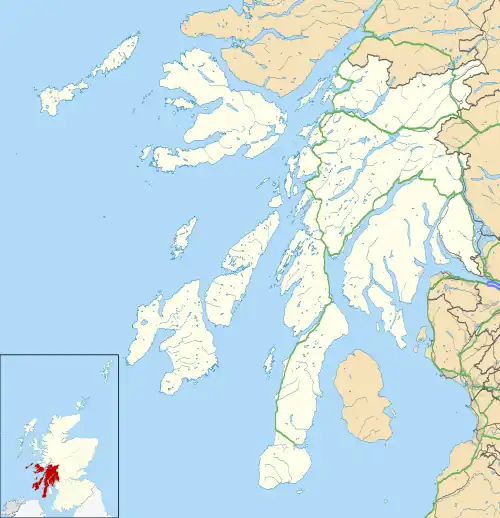| Cove Burgh Hall | |
|---|---|
.jpg.webp) Cove Burgh Hall | |
| Location | Shore Road, Cove |
| Coordinates | 55°59′17″N 4°50′53″W / 55.9880°N 4.8481°W |
| Built | 1893 |
| Architect | James Chalmers |
| Architectural style(s) | Scottish Renaissance style |
Listed Building – Category B | |
| Official name | Shore Road, Cove Burgh Hall and Reading Room |
| Designated | 8 September 1980 |
| Reference no. | LB43428 |
 Shown in Argyll and Bute | |
Cove Burgh Hall is a municipal structure in Shore Road in Cove, Argyll and Bute, Scotland. The structure, which is used as a community events venue, is a Category B listed building.[1]
History
In 1889, three letters were sent to the Helensburgh News complaining about the lack of a burgh hall in Cove.[2] In response, the founder of Clan Line, Sir Charles Cayzer, 1st Baronet, who, in 1890, had bought Clevedon House in Cove for use as his summer house, agreed to become provost of the burgh of Cove and Kilcreggan in 1891[3] and, in that capacity, to launch an initiative to erect a bespoke building for the burgh. The building was financed by public subscription with most of the funding coming from the wealthy inhabitants of the burgh including Cayzer, who personally contributed £500. The site chosen on Shore Road was made available at a subsidised feu by the landowner, George Campbell, 8th Duke of Argyll, whose seat was at Inveraray Castle.[4]
The building was designed by James Chalmers of Glasgow in the Scottish Renaissance style, built in rubble masonry with red sandstone dressings at a cost of £2,300 and was officially opened by the then-provost, Peter Donaldson, on 10 May 1893.[4][5] The design involved an asymmetrical main frontage with four bays facing onto Shore Road. The first bay on the left was formed by a single-storey gabled block; the second bay, which projected forward, was formed by a two-storey gabled block with three segmental windows on the ground floor flanked by brackets supporting a balustraded balcony, and a tri-partite mullioned and transomed window surmounted by an open pediment on the second floor; the third bay was formed by a three-stage circular tower, which featured a tall dormer window in the third stage and was surmounted by a conical roof; the fourth bay was formed by a two-storey gabled block with a wide arched entrance, which was encircled by ornate voussoirs and surmounted by a carved coat of arms, on the ground floor, with a sash window surrounded by an architrave on the first floor.[1] Internally, the principal rooms were the main assembly hall, which could accommodate about 130 people, and the library.[6]
The building continued to serve as the meeting place of the burgh council for much of the 20th century but ceased to be the local seat of government when the enlarged Argyll District Council was formed in 1975.[7][8] Following the creation of unitary authorities in 1996, Argyll and Bute Council inherited the building and announced, in February 1999, that it would close the building because of the high cost of maintenance. In response, a former director of Clugston Group, Peter Holland, led an initiative to acquire the building for a nominal sum and to refurbish it.[9] An extensive programme of works, which included new windows, a new heating system and roof repairs, was completed in autumn 2001.[4]
The building was subsequently used as a community events venue with regular meetings being held by organisations such as the Cove and Kilcreggan Film Society[10] and the Cove and Kilcreggan Literary Society.[11] Speakers at the annual Cove and Kilcreggan Book Festival have included the crime writer, Sir Ian Rankin, the journalist Jon Snow,[12] the broadcaster, Sally Magnusson,[13] the journalist, Melanie Reid,[14] and the crime writer, Val McDermid.[15]
See also
References
- 1 2 Historic Environment Scotland. "Shore Road, Cove Burgh Hall and Reading Room (LB43428)". Retrieved 12 July 2022.
- ↑ "The Cayzers at Cove 1885 – 1918, Part 2". Cayzer Family Archive. Retrieved 12 July 2022.
- ↑ Moss, Michael S (December 2007). "Cayzer family (per. 1843–1999), shipowners and businessmen". Oxford Dictionary of National Biography (online ed.). Oxford University Press. doi:10.1093/ref:odnb/75942. Retrieved 12 July 2022. (Subscription or UK public library membership required.)
- 1 2 3 "History". Cove Burgh Hall. Retrieved 12 July 2022.
- ↑ "Burgh Hall". Dictionary of Scottish Architects. Retrieved 12 July 2022.
- ↑ "Facilities". Cove Burgh Hall. Retrieved 12 July 2022.
- ↑ "Local Government (Scotland) Act 1973". Legislation.gov.uk. Retrieved 29 March 2021.
- ↑ "Cove and Kilcreggan Burgh". Vision of Britain. Retrieved 12 July 2022.
- ↑ "Peter Holland Civil engineer who used his skills to help others". Herald Scotland. 11 February 2005. Retrieved 12 July 2022.
- ↑ "Cove and Kilcreggan Film Society". Independent Cinema Office. Retrieved 12 July 2022.
- ↑ "Literary Society returns to Cove Burgh Hall". The Lochside Press. 11 September 2021. Retrieved 12 July 2022.
- ↑ "Crime, Food and News on Fest Menu". Helensburgh and Lomond Community Advertiser. 1 October 2017. p. 5. Retrieved 12 July 2022.
- ↑ "Cove and Kilcreggan Book Festival 2018". Helensburgh Advertiser. 30 November 2018. Retrieved 12 July 2022.
- ↑ "Melanie Reid at Cove and Kilcreggan Book Festival 2019". The Open University. 23 November 2019. Retrieved 12 July 2022.
- ↑ "Cove & Kilcreggan Book Festival — 2020 edition". Creative Scottish Literature. 12 May 2021. Retrieved 12 July 2022.